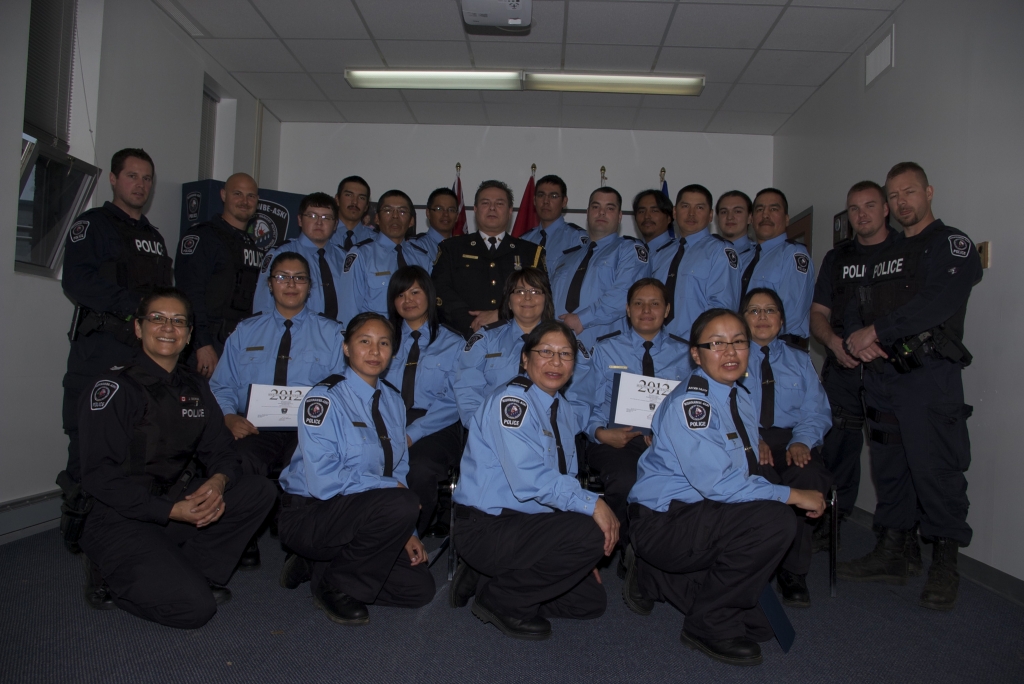A mother of five wants to increase awareness of policing among children and youth in her community after graduating from Nishnawbe-Aski Police Service’s Auxiliary Constable program.
“It will help me to be a role model in my community,” said Mattagami’s Deanna Heyte, one of 18 auxiliary constables who graduated on May 4 at NAPS headquarters in Thunder Bay. “It will allow them (children and youth) to be able to ask questions and maybe help them in deciding to take a career in policing as well.”
Slate Falls’ Lenny Tyler Loon said the Auxiliary Constable program was “a blast.”
“We undertook firearms training, which was awesome,” Loon said. “Just having the NAPS ERT (Emergency Response Team) members training us the entire week was phenomenal. It was really well coordinated and just an awesome experience in every way.”
Loon is looking forward to serving his own community.
“I’ll be assisting with maintaining the peace and ensuring the law is upheld along with regular constables,” Loon said. “The community will benefit by having one of its own band members out visibly assisting the regular NAPS officers. Hopefully, it will make the community more friendly towards the police service.”
NAPS chief of police Claude Chum said the Auxiliary Constable program is part of his vision to get more community members involved in policing, noting that 18 auxiliary constables graduated this year and eight last year. The program has been operating since 2004.
“This is history in the making,” Chum said, explaining the increase in auxiliary constable graduates is part of his goal to improve policing in the communities. “I’ve been telling the chiefs of our communities that is what my goal is, my vision. We have to start recruiting our own people.”
Chum said the auxiliary constables are provided with the same training as the regular constables.
“They learn how to use batons, pepper spray, hand cuffs, hand-to-hand combat tactics, communications, how to arrest somebody or what the arrest procedures are,” Chum said. “This is the same kind of training our police officers go through, but it’s the fast version. They are not going to be carrying a firearm, they are not going to be carrying any weapons.”
The auxiliary constables were also trained in First Nation awareness, policy and procedures, physical fitness, firearms, Criminal Code law, notebook entries, use of force and defensive tactics.
Attawapiskat’s Martha K. Kataquapit said the Auxiliary Constable program means the future to her and her community.
“It means my future, it means my people, it means my land, it means a lot to me,” Kataquapit said.
“I just hope I can be an example for the youth and other people can encourage them to try something that they never had tried.”
Kataquapit said the training was exciting, challenging and rewarding.
“I met wonderful people,” Kataquapit said. “I loved it; I hope I can do more in the future.”
The auxiliary constables’ role is to assist NAPS police officers by performing 20 hours of volunteer service per month in their communities: Moose Factory, Aroland, Mattagami, Attawapiskat, Constance Lake, Kasabonika, Eabametoong, Slate Falls, Sandy Lake, Neskantaga, Mishkeegogamang, Webequie and Cat Lake.
Moose Factory’s Chris Alisappi said the Auxiliary Constable program is a steppingstone for him to gain experience working with NAPS for a potential career in policing.
“I’m from the community and I know the social issues that are there right now and it will feel pretty great to be involved and to help assist in these issues and even help control it,” Alisappi said.
Gold has arrived.










Gold has arrived. Here in the north of Ontario we see vast streams of gold shimmering across the landscape as autumn is here and the the leaves are turning...
I am the product, evolution of many thousands of years as are you. I grew up on the land in the remote far north of Ontario following in the footsteps of my...